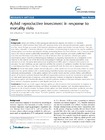Aphid reproductive investment in response to mortality risks
dc.contributor.author
Barribeau, Seth M.
dc.contributor.author
Sok, Daniel
dc.contributor.author
Gerardo, Nicole M.
dc.date.accessioned
2018-05-23T09:42:10Z
dc.date.available
2017-06-09T06:02:21Z
dc.date.available
2018-05-23T09:42:10Z
dc.date.issued
2010-08
dc.identifier.issn
1471-2148
dc.identifier.other
10.1186/1471-2148-10-251
en_US
dc.identifier.uri
http://hdl.handle.net/20.500.11850/23709
dc.identifier.doi
10.3929/ethz-b-000023709
dc.description.abstract
Background
Aphids are striking in their prodigious reproductive capacity and reliance on microbial endosymbionts, which provision their hosts with necessary amino acids and provide protection against parasites and heat stress. Perhaps as a result of this bacterial dependence, aphids have limited immune function that may leave them vulnerable to bacterial pathogens. An alternative, non-immunological response that may be available to infected aphids is to increase reproduction, thereby ameliorating fitness loss from infection. Such a response would reduce the need to mount a potentially energetically costly immune response, and would parallel that of other hosts that alter life-history traits when there is a risk of infection. Here we examined whether pea aphids (Acyrthosiphon pisum) respond to immunological challenges by increasing reproduction. As a comparison to the response to the internal cue of risk elicited by immunological challenge, we also exposed pea aphids to an external cue of risk - the aphid alarm pheromone (E)-β-farnesene (EBF), which is released in the presence of predators. For each challenge, we also examined whether the presence of symbionts modified the host response, as maintaining host fitness in the face of challenge would benefit both the host and its dependent bacteria.
Results
We found that aphids stabbed abdominally with a sterile needle had reduced fecundity relative to control aphids but that aphids stabbed with a needle bearing heat-killed bacteria had reproduction intermediate, and statistically indistinguishable, to the aphids stabbed with a sterile needle and the controls. Aphids with different species of facultative symbiotic bacteria had different reproductive patterns overall, but symbionts in general did not alter aphid reproduction in response to bacterial exposure. However, in response to exposure to alarm pheromone, aphids with Hamiltonella defensa or Serratia symbiotica symbiotic infections increased reproduction but those without a facultative symbiont or with Regiella insecticola did not.
Conclusions
Overall, our results suggest that pea aphids are able to increase their reproduction in response to specific cues and that symbiont presence sometimes moderates this response. Such increased reproduction in response to risk of death increases the fitness of both aphids and their vertically transmitted symbionts, and since these organisms have high reproductive capacity, slight increases in reproduction could lead to a very large numerical advantage later in the season. Thus both symbiotic partners can benefit by increasing host fecundity under dangerous conditions.
en_US
dc.format
application/pdf
en_US
dc.language.iso
en
en_US
dc.publisher
BioMed Central
en_US
dc.rights.uri
http://creativecommons.org/licenses/by/2.0/
dc.subject
Alarm Pheromone
en_US
dc.subject
Sterile Needle
en_US
dc.subject
Fava Bean
en_US
dc.subject
Aphid Clone
en_US
dc.subject
Secondary Symbiont
en_US
dc.title
Aphid reproductive investment in response to mortality risks
en_US
dc.type
Journal Article
dc.rights.license
Creative Commons Attribution 2.0 Generic
ethz.journal.title
BMC Evolutionary Biology
ethz.journal.volume
10
en_US
ethz.journal.abbreviated
BMC evol. biol.
ethz.pages.start
251
en_US
ethz.size
11 p.
en_US
ethz.version.deposit
publishedVersion
en_US
ethz.identifier.wos
ethz.publication.place
London
en_US
ethz.publication.status
published
en_US
ethz.leitzahl
03330 - Schmid-Hempel, Paul
en_US
ethz.leitzahl.certified
03330 - Schmid-Hempel, Paul
ethz.date.deposited
2017-06-09T06:02:27Z
ethz.source
ECIT
ethz.identifier.importid
imp59364d19433b266083
ethz.ecitpid
pub:38778
ethz.eth
yes
en_US
ethz.availability
Open access
en_US
ethz.rosetta.installDate
2017-07-15T15:48:28Z
ethz.rosetta.lastUpdated
2024-02-02T04:52:24Z
ethz.rosetta.versionExported
true
ethz.COinS
ctx_ver=Z39.88-2004&rft_val_fmt=info:ofi/fmt:kev:mtx:journal&rft.atitle=Aphid%20reproductive%20investment%20in%20response%20to%20mortality%20risks&rft.jtitle=BMC%20Evolutionary%20Biology&rft.date=2010-08&rft.volume=10&rft.spage=251&rft.issn=1471-2148&rft.au=Barribeau,%20Seth%20M.&Sok,%20Daniel&Gerardo,%20Nicole%20M.&rft.genre=article&rft_id=info:doi/10.1186/1471-2148-10-251&
Files in this item
Publication type
-
Journal Article [128857]

